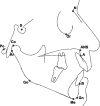Cephalometric features in isolated growth hormone deficiency
- PMID: 21341997
- PMCID: PMC8919754
- DOI: 10.2319/102210-618.1
Cephalometric features in isolated growth hormone deficiency
Abstract
Objective: To analyze cephalometric features in adults with isolated growth hormone (GH) deficiency (IGHD).
Materials and methods: Nine adult IGHD individuals (7 males and 2 females; mean age, 37.8 ± 13.8 years) underwent a cross-sectional cephalometric study, including 9 linear and 5 angular measurements. Posterior facial height/anterior facial height and lower-anterior facial height/anterior facial height ratios were calculated. To pool cephalometric measurements in both genders, results were normalized by standard deviation scores (SDS), using the population means from an atlas of the normal Brazilian population.
Results: All linear measurements were reduced in IGHD subjects. Total maxillary length was the most reduced parameter (-6.5 ± 1.7), followed by a cluster of six measurements: posterior cranial base length (-4.9 ± 1.1), total mandibular length (-4.4 ± 0.7), total posterior facial height (-4.4 ± 1.1), total anterior facial height (-4.3 ± 0.9), mandibular corpus length (-4.2 ± 0.8), and anterior cranial base length (-4.1 ± 1.7). Less affected measurements were lower-anterior facial height (-2.7 ± 0.7) and mandibular ramus height (-2.5 ± 1.5). SDS angular measurements were in the normal range, except for increased gonial angle (+2.5 ± 1.1). Posterior facial height/anterior facial height and lower-anterior facial height/anterior facial height ratios were not different from those of the reference group.
Conclusions: Congenital, untreated IGHD causes reduction of all linear measurements of craniofacial growth, particularly total maxillary length. Angular measurements and facial height ratios are less affected, suggesting that lGHD causes proportional blunting of craniofacial growth.
Figures



References
-
- Huggare JÅ, Rönning O. V. Growth of the cranial vault: influence of intracranial and extracranial pressures. Acta Odontol Scand. 1995;53:192–195. - PubMed
-
- Kiliaridis S. Masticatory muscle influence on craniofacial growth. Acta Odontol Scand. 1995;53:196–202. - PubMed
-
- Kjaer I. Human prenatal craniofacial development related to brain development under normal and pathologic conditions. Acta Odontol Scand. 1995;53:135–143. - PubMed
-
- Ronning O. Basicranial synchondroses and the mandibular condyle in craniofacial growth. Acta Odontol Scand. 1995;53:162–166. - PubMed
-
- Persson M. The role of sutures in normal and abnormal craniofacial growth. Acta Odontol Scand. 1995;53:152–161. - PubMed
MeSH terms
Substances
LinkOut - more resources
Full Text Sources

